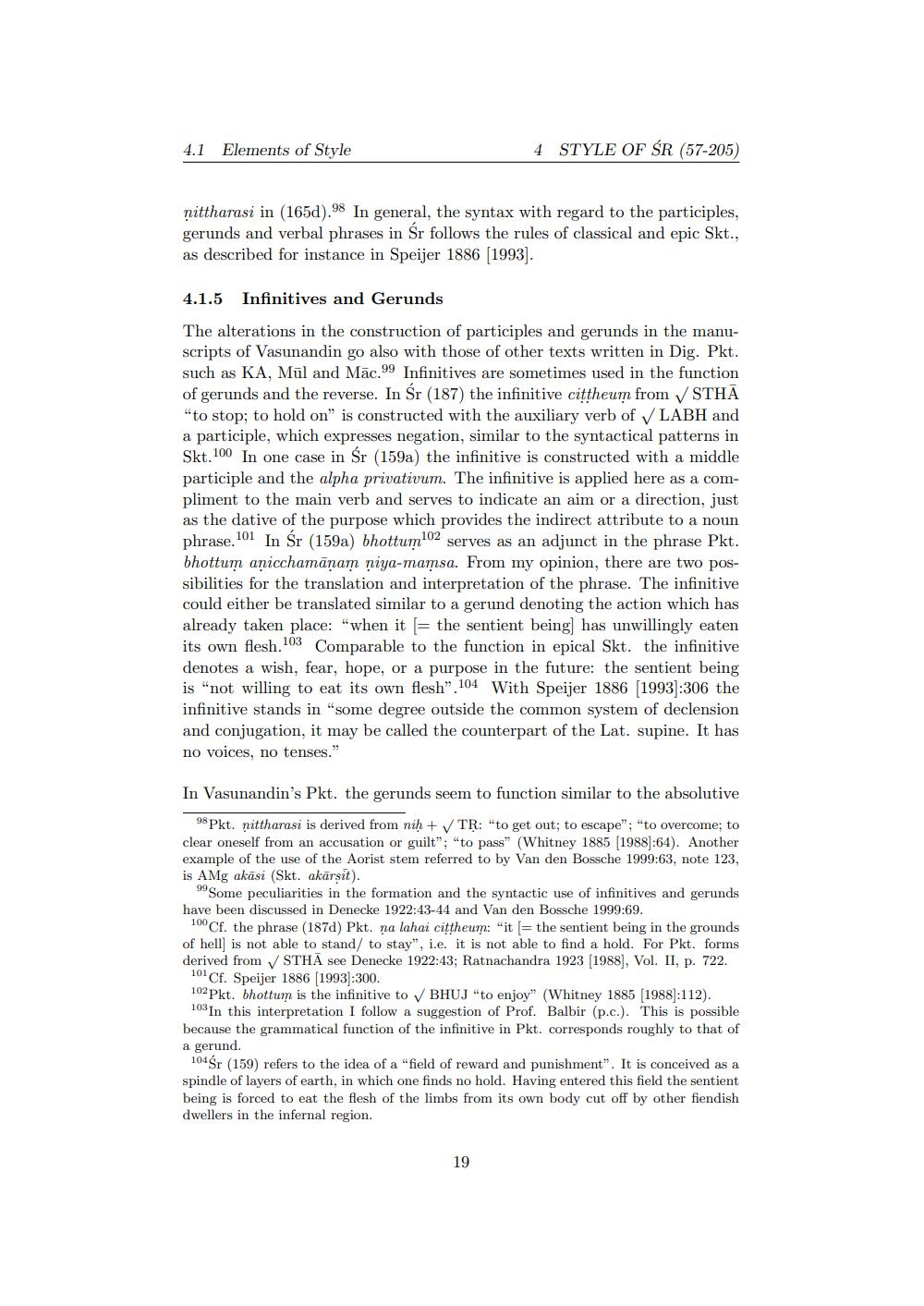________________
4.1 Elements of Style
4 STYLE OF ŚR (57-205)
nittharasi in (165d).98 In general, the syntax with regard to the participles, gerunds and verbal phrases in Sr follows the rules of classical and epic Skt., as described for instance in Speijer 1886 [1993].
4.1.5
Infinitives and Gerunds
The alterations in the construction of participles and gerunds in the manuscripts of Vasunandin go also with those of other texts written in Dig. Pkt. such as KA, Mül and Mac.99 Infinitives are sometimes used in the function of gerunds and the reverse. In Sr (187) the infinitive cittheum from STHA "to stop; to hold on" is constructed with the auxiliary verb of LABH and a participle, which expresses negation, similar to the syntactical patterns in Skt.100 In one case in Śr (159a) the infinitive is constructed with a middle participle and the alpha privativum. The infinitive is applied here as a compliment to the main verb and serves to indicate an aim or a direction, just as the dative of the purpose which provides the indirect attribute to a noun phrase. 101 In Sr (159a) bhottum102 serves as an adjunct in the phrase Pkt. bhottum anicchamanam niya-mamsa. From my opinion, there are two possibilities for the translation and interpretation of the phrase. The infinitive could either be translated similar to a gerund denoting the action which has already taken place: "when it = the sentient being has unwillingly eaten its own flesh.103 Comparable to the function in epical Skt. the infinitive denotes a wish, fear, hope, or a purpose in the future: the sentient being is "not willing to eat its own flesh". 104 With Speijer 1886 (1993):306 the infinitive stands in "some degree outside the common system of declension and conjugation, it may be called the counterpart of the Lat. supine. It has no voices, no tenses."
In Vasunandin's Pkt. the gerunds seem to function similar to the absolutive
98 Pkt. pittharasi is derived from nih + TR: "to get out; to escape"; "to overcome; to clear oneself from an accusation or guilt"; "to pass" (Whitney 1885 (1988):64). Another example of the use of the Aorist stem referred to by Van den Bossche 1999:63, note 123, is AMg akāsi (Skt. akārsit).
99 Some peculiarities in the formation and the syntactic use of infinitives and gerunds have been discussed in Denecke 1922:43-44 and Van den Bossche 1999:69.
100Cf. the phrase (1870) Pkt. na lahai cittheum: "it = the sentient being in the grounds of hell is not able to stand/ to stay", i.e. it is not able to find a hold. For Pkt. forms derived from STHA see Denecke 1922:43; Ratnachandra 1923 (1988), Vol. II, p. 722. 101 Cf. Speijer 1886 [1993]:300. 102 Pkt. bhottum is the infinitive to BHUJ "to enjoy" (Whitney 1885 (1988):112). 103 In this interpretation I follow a suggestion of Prof. Balbir (p.c.). This is possible because the grammatical function of the infinitive in Pkt. corresponds roughly to that of a gerund.
104Śr (159) refers to the idea of a "field of reward and punishment". It is conceived as a spindle of layers of earth, in which one finds no hold. Having entered this field the sentient being is forced to eat the flesh of the limbs from its own body cut off by other fiendish dwellers in the infernal region.




